Soldiers of the Regiment
Lieutenant Colonel Alfred Dykes
The
museum is very pleased to report the acquisition of a collection of
papers relating to Alfred McNair Dykes of the King's Own Royal Lancaster
Regiment. Alfred Dykes was commissioned into the regiment in 1894
and served with both the 1st and 2nd Battalions, including active service
in South Africa 1899-1902 where he was wounded at
Spion Kop.
Listing of the Letters & archive of Lieutenant
Colonel Alfred McNair Dykes, 1885-1914
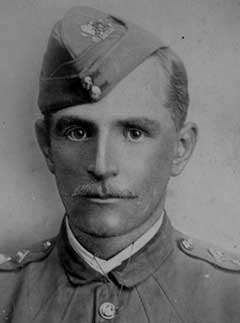
Captain Alfred Dykes in 1901 photographed in Dundee,
South Africa.
Accession Number KO2654/052
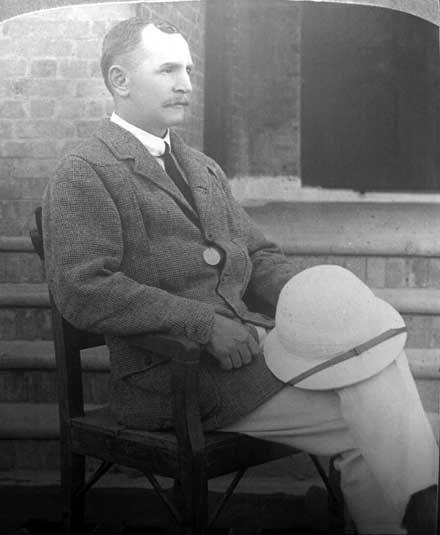
Lieutenant Colonel A M Dykes
Accession Number: KO0460/05
Colonel Dykes took command of the 1st Battalion, King's Own Royal
Lancaster Regiment, in 1913 and it was he who led them to France on 23rd
August 1914 - he was killed at Le Cateau three days later as the German
army advanced into France.
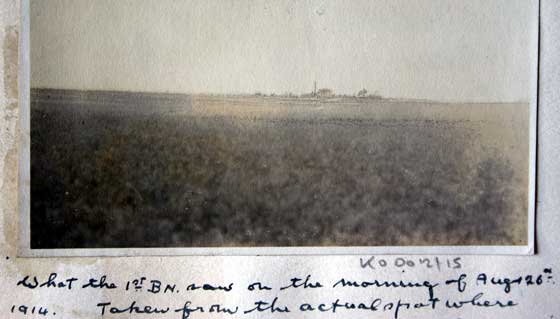
"What the 1st Battalion saw on the morning of 26th August 1914.
Wambaix Station in the background. Taken from the actual spot
where Lieutenant Colonel Dykes was killed."
Accession Number: KO0012/15
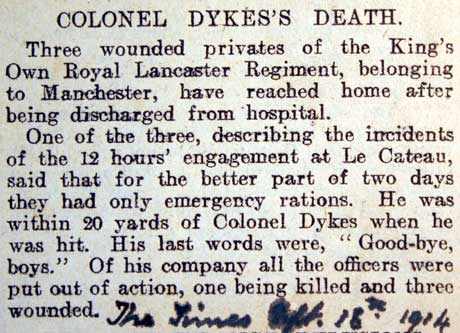
The Times Newspaper, September 1914
Accession Number: KO2654/099
The archive was purchased at auction in December 2006 and includes
family letters, photographs and other items of interest.
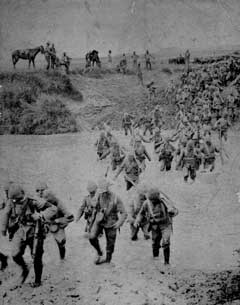
Photograph showing the 2nd
Battalion King's Own Royal Lancaster Regiment crossing the Zand Spruit at
low water between Dundee and De Jagers Drift. Alfred Dykes is
standing next to the horse on the river bank.
Accession Number KO2654/056
As the First
World War started, Alfred Dykes wrote to his mother on 5th August 1914:
“I was fully convinced
that unless we, as a nation, were to sacrifice our honour, we were bound
to go to war. First, in accordance with our most solemn obligations to
France and Belgium. Secondly, to preserve our existence as a Nation and
an Empire. Consequently without waiting for orders, I got to work at once
on the great work of mobilisation, last Monday morning. I am now
thankful; for though we are terribly busy, a great deal was done before
the order arrived yesterday at 5 O’clock. We are now more than a day
ahead of our programme and have saved a great deal of rush. ….we are
awaiting the arrival of reservists, who will be pouring in tomorrow and
subsequent days. My battalion will then be 31 officers and 1037 other
ranks. [Battalion Orders of 4 Aug 1914 listed peace time strength of
631].
One thing only I do ask
you and that is to accept the news and whatever comes of it, with the calm
strength and bravery which you have always shown in times of stress. We
are all happy and full of confidence and I think that rarely never did war
begin in a more thoroughly just cause.
You used to think me
cynical, I think, in our Billiard Room War Councils when I used to air my
views on the value of German Treaties, Vows and Protestations. There is
no need to ‘crow’! The truth of all I said stands self evident today. On
the heads of the German and Austrian Emperors, who have plotted and
planned all this, for years, while professing peace…..”
Accession Number
KO2654/036
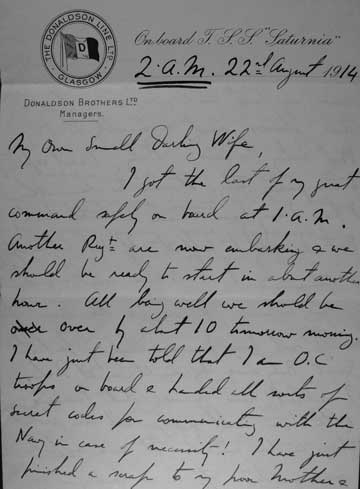
The last letter
from Dykes to his wife, written on board the SS Saturnia on board which
the 1st Battalion travelled to France on 23rd August 1914.
Accession Number KO2654/040
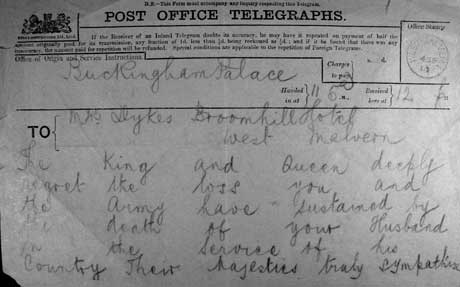
Telegram from Buckingham Palace, dated 4th September 1914 to Mrs Dykes,
Broomfield Hotel, Malvern. “The King and Queen deeply regret the loss you
and the Army have sustained by the death of your husband in the Service of
his Country. Their Majesties truly sympathise with you in your sorrow,
Private Secretary”
Accession Number KO2654/042
11th September 1914 - Lancaster Observer
The “Roll of Honour”
How Colonel Dykes was Killed. Officers’ Bravery and Heroism
A story told by a sergeant of the King’s Own gives some brief intimation
of how Colonel Dykes and two of his officers met their death. Here is
the story, told with laconic bluntness – a soldier’s description, in
fact, of an engagement which a war correspondent would have been able to
present in thrilling fashion: The King’s Own with the Lancashire
Fusiliers and the Middlesex Regiment were ordered to cover the retreat
of the allied forces from Mons. On Tuesday 25th August, they left the
position in which they had been entrenched to take new ground, and were
marching through the night, finding themselves at day break between
Cambrai and Le Cateau. Several French regiments and a Highland regiment
had passed their lines, when as the King’s Own were taking breakfast,
the German artillery boomed forth. Several shells fell in the vicinity
of the trenches without doing much harm, but the enemy’s artillery was
much superior in numbers to that of the allies, and they poured in a
raking shrapnel fire before the English guns began to speak. There was
no doubt either about the enemy’s range finding, under cover of the guns
the enemy came on in the proportion of six to one. Men were mowed down
like ninepins by the bursting shrapnel, and it seemed as though the
King’s Own had been singled out for the special fury of the onslaught.
Colonel Dykes fell at an early stage of the engagement while shouting
encouragement to his men. Fighting continued furiously from 4.30 until
9.30. Then there was a lull, and the enemy, seemingly reinforced, made
good their advance, and another five hours’ desperate conflict ensued.
The allies fought the advance inch by inch, fighting becoming so close
that the King’s Own got home with several dashing bayonet charges. One
of the most brilliant of these bayonet charges was led by Captain
Clutterbuck, who, with a handful of men, routed four times the number of
men under this command. He paid the price of his gallantry with his
life, but the casualties to his men were singularly light. The sergeant
said, “It was just like Clutterbuck.”
“Then,” continued the sergeant, “there was Lieutenant Steele-Perkins,
who died one of the grandest deaths a British officer could wish for. He
was lifted out of the trenches wounded four times, but, protesting,
crawled back again till he was mortally wounded. The first man knocked
over was one of the most popular of the Rugby footballers in the Dover
garrison. He was shot through the mouth. Lieutenant Woodgate
distinguished himself in bravery, and Major Parker was coolness
personified.
“A German aeroplane,” proceeded the sergeant “which came over our
position on the day preceding the battle was accounted for; assailed by
a shower of bullets from more than one regiment, its reconnoitring
career had a sudden stop. The enemy swooped down on us so quickly at the
finish that we were unable to remove all our dead and wounded. Stretcher
bearers were shot down, and I, who had been wounded with a shrapnel
bullet in the muscle of the left arm, was taking a message for the
doctor from the field hospital (a school) when a shell came and
demolished the roof. All the King’s Own dead are buried in France, a few
miles from the frontier. We saw many burning villages, and our artillery
helped along many old women and children who were fleeing before the
enemy.”
Colonel Dykes’ Distinguished Career
Colonel Dykes was born in 1874, and was the son of the late Mr William
Ashton Dykes, of The Orchard, Hamilton, NB, an of Mrs Dykes who is still
alive. He was educated at Glenalmond, and in 1894 received his
commission in the King’s Own, passing in through the militia. He
received the highest number of marks of any of his competitors. In his
early twenties, as a subaltern, he became adjutant of the regiment,
serving in that capacity in South Africa, rejoining his regiment after
having done duty for a short time as embarkation officer. He was
dangerously wounded at Spion Kop, in the vicinity of the Boer Trenches,
and an endeavour to locate their exact position. He was invalided home,
but in a few months he returned to the seat of war, where he was
employed on convoy duty. He distinguished himself in the defence of
Vryheid, successfully repulsing an attack by Louis Botha in greatly
superior numbers. He was twice mentioned in despatches, and was offered
the choice of DSO or a brevet majority. He chose the latter, being then
but 27 years of age. He received the Queen’s medal with four clasps, and
the King’s medal with two clasps. He was staff captain at the War Office
between 1904-08. He had also passed through the staff college, and for a
short time he was in command of a company of gentlemen cadets at
Sandhurst. On the death of Colonel Marker in August last year he was
appointed to the command of the 1st Battalion of the regiment. He was
then but 39 years of age, and was the youngest lieutenant colonel in the
line. To his fine soldierly qualities were added an extreme personal
charm, and inexhaustible fund of humour. He was beloved by both officers
and men in all the positions he occupied. On the 21st April this year he
was married in London to Rosamund Ann, daughter of the late Mr Frederic
Willis Farrer, and of Mrs Farrer, of 26 Palace Court.
6th November 1914 - Lancaster Observer
Soldiers’ Stories
Another story of Colonel Dykes’ Death.
Private James Ford, of the King’s Own Royal Lancasters, who is at
Northwich wounded in the foot, has re-told the story of the engagement
forty miles from Mons. He said:- “Our colonel was the first man to die.
It was a brave sight, and I shall never forget it. As he lay on the
ground he shouted, ‘Good bye, boys’ and then passed away. This was a
brave death, and that of a true Englishman. In all 640 of our men went
down, and the regiment was terribly cut up. As we retreated, doing no
less than thirty miles in a day, we came across women and children
fleeing from the scene of battle. The Uhlans are a bad lot, and are far
worse than the ordinary German soldiers. When I was struck on the foot I
fell against a tree and broke my watch. It was a knack of our men to
crowd all sorts of small articles into their clothing, thinking they
might stop a bullet or reduce its speed. I have known many cases of
lives being saved in this manner.








